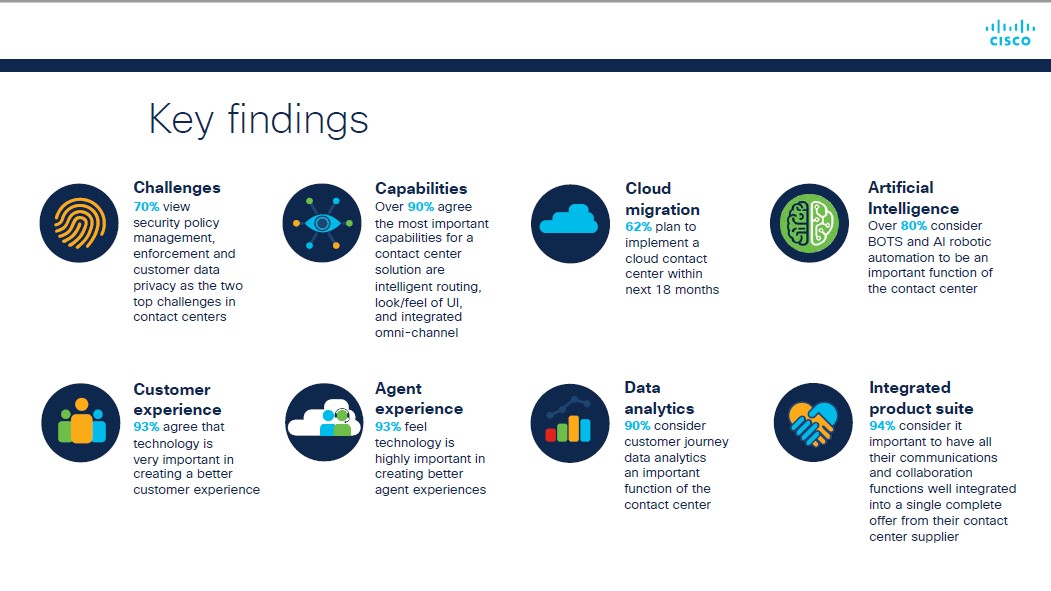[responsivevoice_button rate=”1″ pitch=”1.2″ volume=”0.8″ voice=”US English Female” buttontext=”Story in Audio”]
Cisco contact centre survey reveals pain points
During these days of lockdown, contact centres are a company’s lifeline for customers, and they’re of necessity rapidly evolving.
Barbara Ferguson, senior product manager, Cisco Contact Centre, told the publication that clients are saying their call volume has doubled or even tripled since the beginning of the pandemic, and Rogers Communications’ chief executive officer Joe Natale told analysts this week that the company now has all of its 7000 agents working from home.
Cisco’s newly released Global Contact Centre Survey 2020 takes a look at what is on the minds of decision-makers in contact centres of all sizes. Conducted by market research firm Dynata on behalf of Cisco, the survey included 700 contact centre decision-makers from seven countries (USA, Canada, France, Germany, Austria, Mexico, and Brazil), across more than ten industries, key among which were information and technology; manufacturing; retail; professional, scientific, and technical services; and finance and insurance. They were a mix of Cisco Contact Center customers (62 per cent) and those using other products, including Amazon, Avaya, Aspect, Five9, Genesys, Mitel, NEC, Nice/InContact, Twilio, Unify, and others.
Of the 700, 14 per cent use public cloud contact centre as a service, 43 per cent have hybrid contact centres, and 42 per cent own systems on-premises or in a private cloud. Most (85 per cent) have between 1 and 999 agents.
Although the interviews were pre-COVID-19, they are a harbinger of things to come. Some of the trends suggested in the results are coming to fruition more quickly than anticipated, noted Omar Tawakol, vice-president and general manager, Cisco Contact Center. While 62 per cent of respondents indicated that they were planning to implement a cloud contact centre within 18 months (35 per cent within the next six months), Tawakol said that today customers are asking how they can move at least part of their call centres cloudwards now, in response to the new reality. Some carrier partners have already shifted over 10,000 agents.

The overall experience for both customers and agents was a key measure in contact centres. More than half (53 per cent) of contact centres report to a customer experience (CX) executive, with top challenges cited as fragmented customer experiences, siloed data, high agent turnover, lack of visibility into the customer journey, and poor communications across the business. Almost three-quarters of respondents (74 per cent) feel agent experience has a significant impact on customer experience, 79 per cent agreed that customer experience has a significant impact on business results, and 93 per cent agreed that technology is very important in creating a better customer experience.
Empowering agents by minimizing cumbersome, repetitive tasks and providing AI-powered context and knowledge in real-time helps them deliver the timely and accurate responses customers expect, the report noted, which in turn leads to improved agent morale and job satisfaction, and thus lower turnover. Given the average cost to onboard an agent, it says, is between $10,000 and $20,000, and it takes 2 – 4 weeks, keeping agents happy is not only good for the people, it’s good for the business, so 70 per cent of respondents said they engage with agents quarterly to identify what’s working and where there are issues.
The survey found that agents are frustrated with both technology and business processes. Disconnected back-end systems, the need to use too many different applications to get the job done, and cumbersome desktop user interfaces were the top three tech issues, while cumbersome and repetitive tasks involved in closing tickets, slow processes due to outdated tech, and too many steps involved were the major process issues. Almost all respondents (93 per cent) feel that technology is highly important in creating better agent experiences.
Using AI, for example, can deflect some of the simpler inbound calls from human agents, leaving them free to deal with more complex issues, said Nikki Heyder, AI and Webex Contact Center product management at Cisco. The report pointed out that chatbots, conversational IVRs, and intelligent agents also help reduce agent burnout and improve the quality of customer-agent time. AI, it said, “amplifies the contact center’s ability to perform at a higher scale.”
Yet the survey revealed that only 48 per cent of contact centres have deployed customer-facing chatbots. Of that group, 70 per cent report a reduction in call volumes.
Additionally, communication emerged as a huge challenge as contact centres increasingly employ subject matter experts to assist agents with calls, with 70 per cent of respondents citing poor communication as a significant problem. Furthermore, 94 per cent consider integrated collaboration functions (messaging, chat, screen sharing, etc) important in contact centre solutions.
Because (especially now), contact centres are so important to the business, the C-suite is watching. Over half (52 per cent) of respondents said that data is shared with the CEO, and a total of 67 per cent said they do so with one or more senior executives, ranging from marketing and sales to R&D and IT. Ninety per cent of respondents consider end-to-end real-time and historical reporting to be important functions of the contact centre because, as the report notes, data-driven insights are central to the business.




























